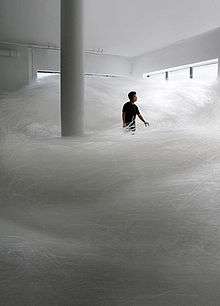Tokujin Yoshioka
| Tokujin Yoshioka | |
|---|---|
| Born |
January 20, 1967 Saga Prefecture, Japan |
| Nationality | Japanese |
| Known for | Design |
| Website |
www |
Tokujin Yoshioka (吉岡 徳仁 Yoshioka Tokujin, born January 20, 1967) is a Japanese artist and designer.
Many of his works are part of the permanent collections of museums worldwide, including the Museum of Modern Art (MoMA) and the Cooper Hewitt National Design Museum in New York, Centre Georges Pompidou in Paris, the Victoria and Albert Museum in London, and the Vitra Design Museum in Germany. In 2007, Yoshioka was selected by the Japanese edition of Newsweek as one of the "100 most respected Japanese by the world." [1]
Biography
Yoshioka was born in Saga Prefecture in 1967. After graduating from Kuwasawa Design School in 1986, he worked under Shiro Kuramata and Issey Miyake before becoming a freelance designer in 1992. In 2000 he established his own office, Tokujin Yoshioka Design.
Office
The office is located in Daikanyamachō, Shibuya, Tokyo. It is a renovated 150-year-old rice warehouse, which was moved to its current place from its original location in Shimane Prefecture.[2]
Works

Yoshioka's recent notable work would be the store design concepts for Swarovski, including his work for the Swarovski flagship in Ginza. In the line of space designs, Yoshioka has been producing the boutique designs for Issey Miyake for more than 20 years, and has provided space designs for Toyota, Hermes, Lexus, Peugeot, NTT, BMW, and for cosmetic brands as RMK and SUQQU, which also involved works for their product package designs. He has also done a number of collaborations with Italian furniture manufactures including Cassina,[3] Driade,[4] Kartell,[5] and Moroso. Some of his furniture works are presented at Salone del Mobile. Other collaborative works in the past include the Yamagiwa lighting "Tofu", the mobile phones design produced for the au design project "Media Skin", the iida "X-Ray", the chandeliers of the Swarovski Crystal Palace, the stool "Eternal", and the fiber chair "Pane Chair". Since 2002, Yoshioka has been working on optical glass projects including "Water block", "Chair that disappears in the rain", and the world biggest optical glass table "Waterfall" and "Water block" is permanently exhibited in Musee d'Orsay, Paris. He has also presented several space installations, including those at the Salone del Mobile for Lexus, Swarovski and Moroso. In 2008, he directed the exhibition "Second Nature" held at 21_21DESIGN SIGHT, Tokyo, where he presented "Venus - Natural crystal chair, " a work based on his theory of applying natural laws into his design, and the installation "Clouds - Installation." The following year in 2009, he directed Cartier's special exhibition "Story of..." - Memories of Cartier Creations, where he exhibited the perfume bottle "Moon Fragment" as a work representing the future of Cartier. In 2010, the exhibition "Tokujin Yoshioka Spectrum" was shown in Korea. This included the partially completed "Rainbow Church" installation, a 9 metre high stained glass consisting of 500 crystal prisms. The "Sensing Nature" exhibition the same year at the Mori Art Museum included the 15 metre-wide dynamic installation "Snow".
Awards
- Mainichi Design Award (2002)
- Bulgari Brilliant Dreams Award 2007
- Good Design Award Golden Award (2007)
- Design Miami / Designer of the Year 2007 (USA)
- Wallpaper Design Awards 2008/ Best furniture designer (UK) (2008)
- Design for Asia Award (DFA Award) / Grand Awards 2008 (Hong Kong)
- Elle Deco International Design Awards / Designer of the Year 2009 (Italy)
- Tokyo Designers Week, Artist of the Year 2010
- A&W Architektur & Wohnen/Designer of the Year 2011
- Maison & Objet/ Creator of the Year 2012
Publications
Collections
- Tokujin Design (Gap Publication) 2001
- Tokujin Yoshioka Design English/Japanese (Phaidon, UK) 2006
- Tokujin Yoshioka (Rizzoli, USA) 2010
- Tokujin Yoshioka Crystallize (Seigensha) 2013
Books
- Invisible Forms (Esquire Magazine Japan) 2009- The first book of Tokujin's design theory.
Newspaper/magazine coverage
Japan
- Cover InterviewーTokujin Yoshioka "Axis" 93rd issue, September–October 2001 (Cover, Cover interview)
- Who is Tokujin Yoshioka? "pen" May 2009 (Cover, Whole magazine)
- Elle Decoe June 2009. (p. 128-130, 39, 143-149) - EDIDA Designer of the year Award
- Aera September 2010. (Cover, cover interview)
International
- "Tokujin Yoshioka" "intramuros"(France) April–May 2002 (Cover, p. 74-81)
- "Tokujin Yoshioka: The Illusionist" "Frame" (Netherland) March–April 2008 (p. 82-93)
- "The Invisible Bar" "Domus" (Italy) March 2008 (Cover, p. 97-101)
- "Alchemy and illusion" "Interni" (Italy) April 2008 (Cover, p. 116-121)
- "Ceding control to a world of random beauty" "International Herald Tribune" Oct. 2008
- "Mother of invention: second nature by Tokujin" "Domus" (Italy) Oct. 2008 (p. 16-23)
- "Year in Ideas" "The New York Times Magazine" (USA) Dec. 2008 (p. 52) - The best idea represents the year
- "The 100 Most Creative People in Business" "Fast Company" (USA) June 2010 (p. 105) - The 100 Most Creative People in Business 2010" by an American economy magazine
- "Into the Light" "Frame" (Netherland) September–October 2010 (p. 154-159)
Television appearances
- "NHK Professionals" The 53rd air. (June 5, 2007) NHK
- "News Zero" (May 8, 2009) Nippon Television
- "Jonetsu Tairiku" (June 20, 2010) Mainichi Hoso TV
- "News 23X" (August 27, 2010) TBS
References
- ↑ Newsweek October 17, 2007 issue
- ↑ Elle Deco, October 2000, No.50
- ↑ "Heaven by Tokujin Yoshioka", dezeen, April 30, 2008, Retrieved January 17, 2011.
- ↑ , Driade spa. Retrieved January 17, 2011.
- ↑ "tokujin yoshioka "the invisibles" for Kartell", designboom, March 2011, Retrieved January 17, 2011.
- ↑ "The Invisibles von Tokujin Yoshioka in Kartell Gallery", May 2010. Retrieved January 17, 2011.
External links
| Wikimedia Commons has media related to Tokujin Yoshioka. |